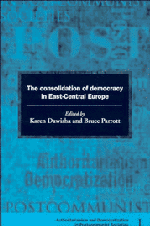Book contents
- Frontmatter
- Contents
- List of tables
- List of contributors
- Preface
- 1 Perspectives on postcommunist democratization
- 2 Democratization and political participation: research concepts and methodologies
- 3 Democratic consolidation in Poland after 1989
- 4 Party politics and political participation in postcommunist Hungary
- 5 Democratization and political participation: the experience of the Czech Republic
- 6 Democratization and political participation in Slovakia
- 7 Democratization and political participation in postcommunist societies: the case of Latvia
- 8 Democratization in Lithuania
- 9 Democratization and political development in Estonia, 1987–96
- Appendix
- Index
9 - Democratization and political development in Estonia, 1987–96
Published online by Cambridge University Press: 01 June 2011
- Frontmatter
- Contents
- List of tables
- List of contributors
- Preface
- 1 Perspectives on postcommunist democratization
- 2 Democratization and political participation: research concepts and methodologies
- 3 Democratic consolidation in Poland after 1989
- 4 Party politics and political participation in postcommunist Hungary
- 5 Democratization and political participation: the experience of the Czech Republic
- 6 Democratization and political participation in Slovakia
- 7 Democratization and political participation in postcommunist societies: the case of Latvia
- 8 Democratization in Lithuania
- 9 Democratization and political development in Estonia, 1987–96
- Appendix
- Index
Summary
Introduction
The following study of political development in Estonia on the eve of the Soviet Union's demise and the early postindependence era focuses on the question of democratization and closely related issues. It stresses the role of the country's previous evolution, especially the experiences of the interwar independence era and the Soviet period, in shaping how Estonia dealt with the political challenges it faced in the years 1987–96. The key theme of the period under review is the non-violent nature of Estonia's democratization process despite ethnic tensions and economic uncertainty. Emboldened by Moscow's weakness and events in Eastern Europe, Estonia quickly turned to the restoration of independence as the only viable option for its future and, along with the other two Baltic states, played a significant role in the coming collapse of the USSR in the years 1988–91. For the period 1991–96 the study assesses the evolution of the new political system, analyzing the Constitution of 1992 and the functioning and interaction of the legislative and executive branches. The electoral system and citizen participation in the electoral process are also analyzed. Political parties in Estonia in the early 1990s have struggled to define their role and to establish strong ties with voters; by 1995–96 there were signs that stable and relatively large parties were beginning to emerge. Finally, the role of various social and economic factors in the process of democratization is examined, including the issue of ethnic relations and the impact of Estonia's successful economic reforms.
- Type
- Chapter
- Information
- The Consolidation of Democracy in East-Central Europe , pp. 334 - 374Publisher: Cambridge University PressPrint publication year: 1997
- 18
- Cited by

